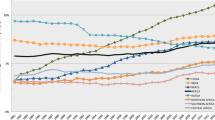Abstract
This article reports for first time the state of science and technology in the African Continent on the basis of two scientometric indicators — number of research publications and number of patents awarded. Our analysis shows that Africa produced 68,945 publications over the 2000–2004 period or 1.8% of the World’s publications. In comparison India produced 2.4% and Latin America 3.5% of the World’s research. More detailed analysis reveals that research in Africa is concentrated in just two countries — South Africa and Egypt. These two counties produce just above 50% of the Continent’s publications and the top eight countries produce above 80% of the Continent’s research. Disciplinary analysis reveals that few African countries have the minimum number of scientists required for the functioning of a scientific discipline. Examination of the Continent’s inventive profile, as manifested in patents, indicates that Africa produces less than one thousand of the world’s inventions. Furthermore 88% of the Continent’s inventive activity is concentrated in South Africa. The article recommends that the African Governments should pay particular attention in developing their national research systems.
Similar content being viewed by others
References
Bernardes, A., Albuquerque, E., (2003), Cross-over, thresholds and the interactions between science and technology: lessons for less-developed countries. Research Policy, 32(5): 867–887.
Braun, T., Schubert, A., Zsindely, S. (1997), Nanoscience and nanotechnology on the balance, Scientometrics, 38(2): 321–325.
DHEW (1970), Towards a Social Report. Department of Health, Education and Welfare, University of Michigan Press, Ann Arbor.
EC (1997), Second European Report on S&T Indicators 1997. European Commission, Directorate General XII, Science, Research and Development, Brussels.
Fordis, B. J., Sung, M. L. (1995), How to avoid patent rejection. Bio/Technology, 13: 42–43.
Griliches, Z. (1990), Patent statistics as economic indicators: A survey. Journal of Economic Literature, 28: 1661–1707.
Hicks, D., Breitzman, T., Olivastro, D., Hamilton, K. (2001), The changing composition of innovative activity in the U.S. — a portrait based on patent analysis. Research Policy, 30: 681–703.
King, D. A. (2004), The scientific impact of nations, Nature, 430: 311–316.
Molatudi, M., Pouris, A., (2006), Assessing the knowledge base for biotechnology in South Africa: A bibliometric analysis of South African microbiology and molecular biology and genetics research. Scientometrics, 68(1): 97–108.
NEPAD (2003), Declaration of the First NEPAD Ministerial Conference on Science and Technology. 7th November 2003, Johannesburg, South Africa.
NSB (2004), Science and Engineering Indicators-2004. National Science Board, Arlington, VA: National Science Foundation.
OECD (2003), Main Science and Technology Indicators. Organisation for Economic Cooperation and Development, Paris.
Pouris, A. (2005), Technological performance judged by American patents awarded to South African inventors. SA Journal of Science, 101: 221–224.
Pouris, A. (2007), Nano scale research in South Africa: a mapping exercise based on scientometrics. Scientometrics, 70(3): 541–553.
Price, De Solla. (1975), The productivity of research scientists. In: Yearbook of Science and the Future, Encyclopaedia Britannica Inc., University of Chicago, Chicago.
Schubert, A., Telcs, A. (1986), Publication potential — An indicator of scientific strength for cross-national comparisons. Scientometrics, 9(5–6): 231–238.
UN Millenium Project (2005), Innovation: Applying Knowledge in Development. Task Force on Science, Technology and Innovation, EarthScan, London, Sterling VA.
United Nations (2003), Science and Technology for Sustainable Development: A Latin American and Caribbean Perspective. Latin American and Caribbean Regional Workshop on Science and Technology for Sustainable Development, Santiago, Chile, 5–8 March 2002, UN, Sustainable Development and Human Settlements Division.
Author information
Authors and Affiliations
Corresponding author
Rights and permissions
About this article
Cite this article
Pouris, A., Pouris, A. The state of science and technology in Africa (2000–2004): A scientometric assessment. Scientometrics 79, 297–309 (2009). https://doi.org/10.1007/s11192-009-0419-x
Received:
Published:
Issue Date:
DOI: https://doi.org/10.1007/s11192-009-0419-x




